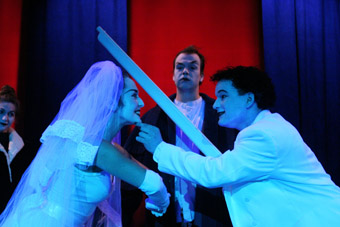 |
Rachael Johnston, Kevin Corey, Clinton Carew, The Black Rider photo Ian Jackson |
As Old Uncle (Mackenzie Gray) barks, other circus members burst through the bright red door, centre stage. Each white-painted face yells, shrieks, their black-lined lips and eyes an invitation to the alluring nightmare The Black Rider promises to be. The performers limit themselves to stiff, doll-like movements in rectangular patterns. Their voices grate, their eyes bulge, the painted curtains glow red behind them. The pitch rises. The combination tips reality like a glass of beer on a table’s edge. Lured in, I’m uncomfortable—but ready to drink whatever's offered next.
What’s next is the love story of Kathchen (Rachael Johnston) and Wilhelm (Kevin Corey), a passionate young woman and a doughy city clerk who wish to marry. But Kathchen comes from a long line of hunters, and her father Bertram will only accept a son-in-law who’ll continue the family tradition. Kathchen wailingly rejects his choice, the lewd hunter Robert, and the mother, Anne, attempts to intervene by reminding Bertram that they were young once too. When Wilhelm discovers how lousy he really is at hunting, he makes a deal with the devil—the limping, tuxedo’d Peg Leg, played dashingly by Michael Scholar Jr—to use magic bullets that always find their mark. The catch: Peg Leg gets to control one bullet, and Wilhelm only discovers which one when he accidentally shoots his bride on their wedding day.
Tom Waits wrote the original songs, adding a spooky texture to a production that foregrounds sound: you don’t put brass on stage and expect it to be subtle. But once I adjusted, I was able to concentrate on the significance of the movement. (The original large-scale Black Rider was created by Waits, Burroughs and Robert Wilson in 1990 and performed in German. Theatre November's own 1998 English language version works with a handful of actors and has been touring internationally since 2000.)
As the generic circus characters melt into their individualized roles, their body language relaxes a little from joint-by-joint gestures, but movement remains formalized throughout. Almost every time the plot intensifies towards a crisis, the performers pace in pathways of right-angled straight lines. This is, I assume, influenced by Robert Wilson’s experimental minimalist style (Wilson with Waits and William S Burroughs created the original version of the work). Anne and Kathchen perform a rigid two-stepping grid of grief around Bertram as they try to convince him he is wrong about Bertram. In Wilhelm’s first successful hunt, the shot stags—four actors holding antlers at their temples—dance around the stage in the now familiar format, haunted and angular. However, the strict, slow movements alternate with acrobatics, tumbling and hysterical arm-flinging.
One slow but atypically fluid scene was particularly moving for me. From stage left, Kathchen takes one step onto stage, raises her arms elegantly in front of her head, and claps. Fine pale dust puffs up from her white-gloved hands. She claps again, takes another slow step, as if her floor-length white dress is weighing her down. She walks beneath the cloud her claps released. Peg Leg stands by the central red door, watching her proceed.
Kathchen, though, is dreamy, and doesn’t register his presence. He turns and leaves. She jerks her torso up and smiles, as if touched from below. It’s Wilhelm, beneath her dress, and laughing. As she sings, her fiancé stays hidden but dances his hands out from under her hem like a flirtatious chorus line of two. The duet—the music of her voice and the physical humour of his hands and later his legs extending her body as he lifts her high—is gorgeous and grotesque, as the production intends their love to be.
By now the circus framework seems far from the story’s action. When a circus-freak hunchback suddenly appears gibbering stage left, soon joined by Old Uncle declaiming loudly about the destructive powers of addiction, stage right, the abrupt transition is jarring and the speech oddly didactic. The feeling of disjunction is confirmed a few minutes later when the plot jumps back to the love story. Having made the effort to accept the characters and their peculiar mannerisms, I prickled at what felt like crass manipulation since the play had already clearly revealed Wilhelm’s risk.
Opening up to The Black Rider’s choreography was rewarding, and I found the main plot wonderfully suspenseful (though the important subplot about Kathchen’s ancestry was clear only when I read the program notes). Strangely, even though there are slow passages such as a completely silent death scene (that seems like five minutes but is in fact much less), the overall dynamic of the production is noisily staccato. That percussive pace keeps a cool gap between the performers and the audience. Maybe it's the slight distance between humans and the devil(ish) that we prefer to maintain.
November Theatre, The Black Rider, The Casting of the Magic Bullets, by Tom Waits, William S Burroughs, Robert Wilson, songs Tom Waits, text William S Burroughs, director Ron Jenkins, performers Mackenzie Gray, Michael Scholar Jnr, Jon Baggaley, Colleen Winton, Rachael Johnston, Kevin Corey, Corinne Kessel, The Devil's Rubato Band, musical director Corinne Kessel, choreographer Maria Nychka, lighting Michael Kruse, properties designer Marissa Kochanski; Arts Club Granville Island Stage, Jan 16-Feb 9; PuSh International Festival of Performing Arts, Jan 16 - Feb 3
Meg Walker is a nomadic fiction and non-fiction writer currently based in Vancouver, where she also spends plenty of time making visual art.
© Meg Walker; for permission to reproduce apply to [email protected]








 back
back